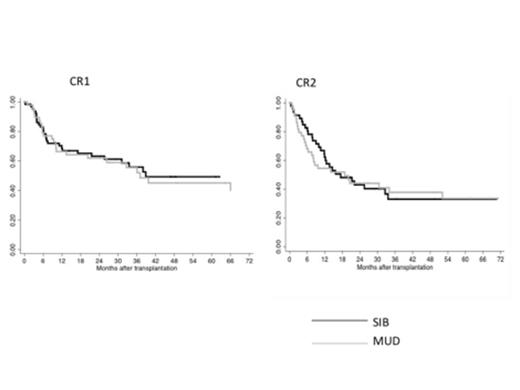Abstract
A landmark study from Medical Research Council/Eastern Cooperative Oncology Group showed improved survival (∼53%) for patients allocated to sibling HCT versus either consolidation/maintenance chemotherapy or autologous HCT. Matched unrelated donors (MUD) are an option for patients without a SIB available and we retrospectively analyzed disease outcomes after SIB and MUD in adult ALL patients.
The summary outcomes
| . | SIB (%) . | MUD (%) . | P . |
|---|---|---|---|
| Neutrophil recovery at day 42 | 96.4 | 97.8 | 0.6 |
| Platelet recovery at day 100 | 92 | 81.5 | 0.03 |
| Grade II-IV aGVHD | 30.2 | 48.3 | 0.009 |
| 3 year TRM in CR1 | 24.6 | 28.7 | 0.6 |
| 3 year TRM in CR2+ | 21.0 | 23.1 | 0.8 |
| 3 year relapse incidence in CR1 | 24.4 | 20.6 | 0.6 |
| 3 year relapse incidence in CR2+ | 49.9 | 39.6 | 0.3 |
| 3 year OS in CR1 | 55.9 | 55.6 | 0.8 |
| 3 year OS in CR2+ | 33.1 | 37.9 | 0.8 |
| . | SIB (%) . | MUD (%) . | P . |
|---|---|---|---|
| Neutrophil recovery at day 42 | 96.4 | 97.8 | 0.6 |
| Platelet recovery at day 100 | 92 | 81.5 | 0.03 |
| Grade II-IV aGVHD | 30.2 | 48.3 | 0.009 |
| 3 year TRM in CR1 | 24.6 | 28.7 | 0.6 |
| 3 year TRM in CR2+ | 21.0 | 23.1 | 0.8 |
| 3 year relapse incidence in CR1 | 24.4 | 20.6 | 0.6 |
| 3 year relapse incidence in CR2+ | 49.9 | 39.6 | 0.3 |
| 3 year OS in CR1 | 55.9 | 55.6 | 0.8 |
| 3 year OS in CR2+ | 33.1 | 37.9 | 0.8 |
Multivariate results for OS*
| . | HR . | 95%CI . | P . |
|---|---|---|---|
| CR1 | Ref | ||
| CR2 | 1.7 | 1.1-2.5 | 0.01 |
| Age <35 | Ref | ||
| Age>=35 | 1.7 | 1.1-2.6 | 0.01 |
| . | HR . | 95%CI . | P . |
|---|---|---|---|
| CR1 | Ref | ||
| CR2 | 1.7 | 1.1-2.5 | 0.01 |
| Age <35 | Ref | ||
| Age>=35 | 1.7 | 1.1-2.6 | 0.01 |
Adjusted for cytogenetics and WBC at diagnosis, donor type and conditioning intensity.
In summary, hematopoietic transplantation using a MUD was associated with slower platelet recovery which could be due to more common use of BM as the stem cell source. Acute GVHD incidence was also higher with MUD transplants but OS was comparable between donor types, even when patients were transplanted in CR1. Thus, in the absence of a SIB donor, a matched unrelated donor is an acceptable donor source for HCT with comparable overall survival.
Qazilbash:Celgene: Membership on an entity’s Board of Directors or advisory committees Other; Millenium: Membership on an entity’s Board of Directors or advisory committees, Membership on an entity’s Board of Directors or advisory committees Other.
Author notes
Asterisk with author names denotes non-ASH members.


This feature is available to Subscribers Only
Sign In or Create an Account Close Modal